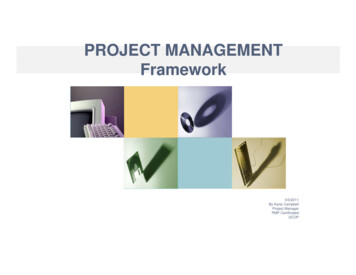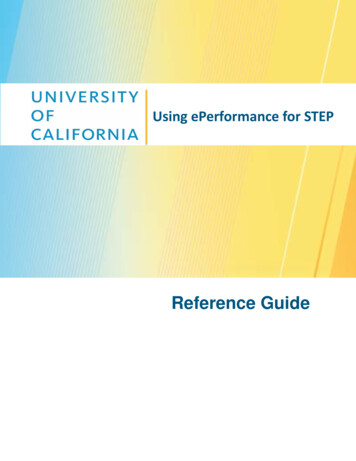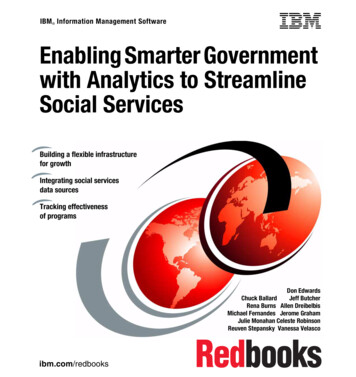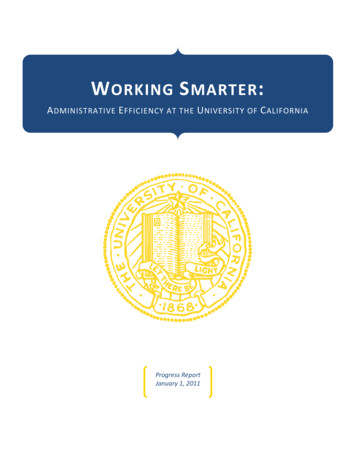
Transcription
W ORKING S MARTER :A DMINISTRATIVE E FFICIENCY AT THE U NIVERSITY OF C ALIFORNIAProgress ReportJanuary 1, 2011
This page left blankintentionally.
Table of ContentsEXECUTIVE SUMMARYPage 4MOVING FAST: HIGHEST PRIORITY NOWapplyUCClimate Solutionse‐Sourcing & Contracts ManagementPayroll Personnel System (PPS) InitiativeProcess Redesign for Capital Improvement Projects PilotRegional Data CentersStudent Health Insurance Plan (SHIP)UC Equipment Maintenance Insurance Program (UCEMIP)UC ReadyUC TrackerPage 8Page 10Page 12Page 14Page 16Page 18Page 20Page 22Page 24Page 26PICKING UP SPEED: NASCENT INITIATIVES, JUST GETTING OFF THE GROUNDAdministrative ReliefAnalytical Writing Placement Examination (AWPE)Campus ConnexionsIndirect Cost RecoveryLibrary EfficienciesLiquidity ManagementMandatory EducationPolicy ProjectUC Strategic Initiative Program (CapEquip, C3, STARs)Page 30Page 32Page 34Page 36Page 38Page 40Page 42Page 44Page 46MAINTAINING MOMENTUM: MORE MATURE, BUT STILL NEED FOCUS AND DRIVEConnexxus Travel ProgramEnterprise Risk Management (ERM)Parent GivingPurchase Card ProgramResearch AdministrationStatewide Energy Partnership (SEP)Strategic Sourcing InitiativeUC Be Smart About Safety (BSAS)UC Travel Insurance Program (UC TRIPS)University Controlled Insurance Program (UCIP)Page 50Page 52Page 54Page 56Page 58Page 60Page 62Page 64Page 66Page 68
WORKING SMARTER: ADMINISTRATIVE EFFICIENCY AT THE UNIVERSITY OF CALIFORNIAAdversity has the effect of eliciting talents which, in prosperous circumstances, would have lain dormant.–HoraceWhile the University of California has long enjoyed world‐renown for its academic and research distinction, ithas not consistently achieved a similar reputation in business administration. Perhaps as a result of strenuouscircumstances, we have reached a turning point.Ten distinctcampusesusing oneefficientadministrativeframework Beginning in July 2009, with Chairman Russell Gould and President Mark Yudof’sCommission on the Future, the University community at large coalesced aroundadministrative and operational effectiveness as a key tenet of long‐term viability. Theconsensus evolved into Working Smarter, an ongoing administrative efficiency initiativethat brings together systemwide, regional, and campus‐level efforts under one umbrellawith one strong commitment from the top: The University is committed to achieving alevel of administrative excellence equivalent to that of its teaching and researchenterprises. Working Smarter envisions ten distinct campuses using one efficientadministrative framework:Common, integrated financial and payroll systemsCommon, integrated time & attendance systemsCommon, integrated extramural fund accountingCommon, integrated data warehousingCommon, integrated asset management Common, integrated e‐procurementCommon, integrated energy and climate solutionsCommon, integrated indirect cost recoveryCommon, integrated library‐efficiency strategiesCommon, integrated risk managementTo reach this objective, the University will: (1) redirect 500 million of positive fiscalimpact in five years from administrative costs to the academic and research missionsof the University; (2) streamline operations in order to address both state fundingcuts and the need for commonality among campuses; (3) implement operationalefficiencies that enhance the quality of services that support our students, faculty,and staff; and (4) build a sustainable financial model to carry the University forward.Comprehensivetravel programwith serviceextended to allCSU campusesand NNSA 500 million ofpositive fiscalimpact in fiveyearsWorking Smarter has already manifested itself across myriad levels and functionalareas of the University. For instance, the University system created Connexxus, anefficient, cost‐effective, and comprehensive travel program utilized across all UClocations. By leveraging volume, the program realized 3 million in savings for fiscalyear 2009‐2010 and is expected to achieve up to 15 million in annual savings by fiscalyear 2011‐2012. Due to the success of the program in a relatively short period of time,the California State University System and the National Nuclear SecurityAdministration have requested to participate in Connexxus, and plans are in place toextend utilization to these organizations.January 1, 20114 P a g e
WORKING SMARTER: ADMINISTRATIVE EFFICIENCY AT THE UNIVERSITY OF CALIFORNIAPooledhealthinsurancefor allgraduatestudentsImplementation of a systemwide UC Graduate Student Health Insurance Plan (GSHIP)began in March, 2010. Five UC campuses as well as the UC Hastings College of the Lawelected to implement the systemwide plan by Fall 2010, with the remaining five campusesexpected to join in Fall 2011. Systemwide GSHIP will enable participating campuses tocollectively purchase a special risk contract to provide comprehensive health insurancebenefits to graduate students. GSHIP is expected to save the University 6 million in fiscalyear 2010‐2011 while simultaneously reducing student costs and increasing benefits. Asubsequent effort to examine and implement a pooled undergraduate student healthinsurance program is also underway.Lack of one‐time investment funding has frequently been a barrier to administrativeefficiency improvements at both the campus and system levels. We are addressing thisproblem through internal‐loan financing programs that leverage the University’s highcredit rating to make low borrowing costs available to campuses for a broader range ofpurposes beyond capital construction. On July 14, 2010, the Regents authorizedCapEquip, the University’s first‐ever capital equipment financing program, which isexpected to save the University 1‐2 million in fiscal year 2011‐2012 by offering campusesan alternative to third‐party equipment leasing. The University also established a similarprogram for strategic working‐capital investments, particularly cross‐campuscollaborations that enhance programmatic and systems commonality.Low‐costinternalloans tofundstrategicinvestmentsThe campuses are also engaged full‐throttle in individual streamlining efforts. TigerTeams at UC San Diego have identified efficiency opportunities in areas like auxiliaryCross‐campusoperations and IT services, with key recommendations now being implemented. Tocollaborations,improve service to their shared community, UC Davis and the City of Davis embarkedupona pilot for joint management of fire departments with full consolidation ofregional centersdepartments under further analysis. In the area of purchasing, UCLA’s strategicof excellence,sourcing contracts are best‐in‐class, and the campus is extending its expertise to sisterand manycampuses in Merced and Santa Barbara. The Operational Excellence effort at UCBerkeley has advanced to the design phase, and execution teams have been formedindividualfrom over 200 faculty and staff nominations received campus‐wide. UC Riversidecampusrecently redesigned its administrative structure to increase effectiveness andstreamlininggenerate much‐needed budgetary savings. UC locations in Berkeley, Davis, Irvine, SanFrancisco, and Santa Cruz, as well as Lawrence Berkeley National Laboratory, haveteamed up on a common human resources information system that introduces considerable functionality formanagement decision‐making and workforce planning.There are countless other examples of efficiency efforts happening at each campus andthroughout the system, and more will continue to develop. The two‐part Working Smarteraction plan calls for continually promoting existing efforts and constantly pushing to keepthe pipeline full. We have already seen that success begets success. Through WorkingSmarter, operational excellence at the University of California can and will progress from astrategy for overcoming adversity to a lasting pillar of UC culture. Operationalexcellence,a pillar ofUC cultureJanuary 1, 20115 P a g e
This page left blankintentionally.
MOVING FAST:HIGHEST PRIORITY NOW
WORKING SMARTER: ADMINISTRATIVE EFFICIENCY AT THE UNIVERSITY OF CALIFORNIAapplyUCBACKGROUNDThe University of California received over 135,000 applicationsfrom prospective students for the Fall 2010 term – 100,000freshmen applicants and 35,000 transfer applicants. Onaverage, each freshman applies to 3.5 UC campuses, and eachtransfer applies to 2.9 UC campuses.All nine undergraduate UC campuses follow commonadmissions policies, and in 1985 a centralized, commonadmissions application process was adopted. Student Affairsat the UC Office of the President is responsible for admissionspolicy and operations while the individual campusUndergraduate Admissions Offices evaluate applications anddetermine admission.The current admissions system is operating in an antiquatedsystems environment which was designed in the early 1980swhen students completed paper applications and mailed themto a central processor. Educational Testing Service (ETS) wasawarded a contract to build and run a custom system for UC –the California Undergraduate Application Processing Service(UCAP) and today handles all functions associated withcentralized admissions.In 1996, an online application was introduced as an option.Today all students apply online, however the underlyingsystems and processes have never been updated. The currentsystems environment is fragmented, with some sub‐systemsoperated by Information Resources and Communications(IR&C) at the UC Office of the President (UCOP) and others byETS. It is inefficient, inadequate, and expensive to operate andmaintain.The applyUC project was initiated in late 2008 with the goal ofmodernizing, streamlining, and reducing the cost of anintegrated centralized undergraduate admissions process.GOALBy building an integrated undergraduate admissionsapplication processing system and automating many of thecentral processor functions, UC can: End the long‐term contract with ETS that is out ofcompliance with current UC purchasing policies; Significantly reduce costs; Eliminate processing bottlenecks in campus admissionsoffices; and, Set the stage for adoption of new cross‐campus processes.The applyUC project is being managed jointly by StudentAffairs and IR&C at the UC Office of the President. The projectteam is working in close collaboration with campus AdmissionsOffice staff.Over the last four years, due to the inflexibility of the legacysystem environment, several automated tools were developedby individual campuses for the benefit of one or more othercampuses. applyUC is designed to accommodate thisdistributed‐systems model, and it has proved to be an effectiveapproach.SUCCESSESIn the first year (2009), the applyUC team set the technologyfoundation and began developing system components. In thesecond year (2010), the team installed a new hardware andsoftware platform to ensure that the peak processing periodruns smoothly. A completely redesigned, modern, and user‐friendly admissions application was built, implemented, anddeployed on October 1, 2010. The project team has metproject milestones on time and within budget.CHALLENGESAs anticipated, managing scope and user expectations hasbeen the most significant challenge. Campus AdmissionsOfficers had pent‐up demand for new system features becausethe legacy systems had been difficult to modify. Keeping acomplicated project on schedule has also been challenging.INITIAL INVESTMENTInitial system development began in December 2008 and isexpected to run through October 2011. The project isexpected to cost 3.4 million, far less than an outsourcedsystems project.Funding has been provided throughapplication fee revenue, a litigation settlement, andanticipated contract reductions.FISCAL RESULTS, CURRENT AND ANTICIPATEDIt is estimated that UC Office of the President will save at least 1.7 million per year when the system is fully implemented. Atthat time the current contract with ETS will bedecommissioned. Savings may be amplified if Student Affairsis able to successfully fold in other current vendor‐supportedwork into a new admissions vendor contract for ancillaryservices.CURRENT ACTIONS AND NEXT STEPSThe updated admissions system is expected to be fullyoperational in Fall 2011. Work is also underway on an RFP forcore ancillary services, such as an applicant help desk, that willcontinue to be performed by an outside vendor.CONCLUDING STATEMENTIn addition to realizing much needed cost savings in the nearterm, the implementation of a modern, robust systemplatform will allow Student Affairs and Campus AdmissionsOffices to collaborate on implementation of additionalefficiencies and cost reductions in future years. January 1, 20118 P a g e
WORKING SMARTER: ADMINISTRATIVE EFFICIENCY AT THE UNIVERSITY OF CALIFORNIACumulative Receipt of Application Fee Revenue ( millions) 25 20 15 102009‐20102010‐20112010‐2011 est. 5 0Figure 1:A clear advantage of applyUC is earlier receipt of application fee revenue. In the current application cycle, UCreceived approximately 20 million in cumulative application fee revenue by December, four months soonerthan the prior year. Received funds can then be invested for an incremental four months, potentiallygenerating an additional 150,000 in investment income to augment campus budgets.January 1, 20119 P a g e
WORKING SMARTER: ADMINISTRATIVE EFFICIENCY AT THE UNIVERSITY OF CALIFORNIACLIMATE SOLUTIONSBACKGROUNDDriven by the imperative of global warming, the University ofCalifornia has committed to achieving carbon neutrality, orzero net emissions of greenhouse gasses (GHG), as soon aspossible. To achieve carbon neutrality without resorting topurchasing offsets, UC must pursue aggressive energyefficiency and conservation efforts, procure massive quantitiesof carbon‐neutral energy, and find a way to negate emissionsfrom its natural gas‐fueled central plants.GOALIn 2007, then‐President Robert Dynes signed the AmericanCollege and University Presidents Climate Commitment(ACUPCC) on behalf of all ten Chancellors. The ACUPCCcommits UC to achieving carbon neutrality “as soon aspossible.” The carbon neutrality commitment is also enshrinedin the Presidential Policy on Sustainable Practices.SUCCESSESIn 2008, the Executive Vice President for Business Operationsconvened the Climate Solutions Steering Group, a team ofcampus and systemwide leaders that is charged with movingUC toward carbon neutrality. Recognizing that no clear path tocarbon neutrality exists, the Climate Solutions Steering Grouphas focused on developing scalable concepts that can berefined as technologies, markets, and regulations develop. Thegroup has identified three strategies to move UC towardcarbon neutrality:1.2.3.Expand use of direct access to implement a cost‐neutralwholesale power procurement strategy that eventuallyprovides UC with electricity that is less carbon‐intensivethan utility‐supplied power. To meet its renewablepower needs, UC must buy power from third‐partygenerators and/or develop its own large‐scale projects,either individually or in partnership with other agencies.Participate in emerging U.S. biogas market to securelarge quantities of carbon‐neutral gas for use in campuscogeneration plants and boilers. Biogas is methanegenerated from controlled decomposition of organicmatter; it is carbon‐neutral, available from a variety offeedstock, and widely used in Europe and China at scale.Large‐scale energy efficiency efforts. Energy efficiencyprojects reduce GHG emissions and campus operatingcosts.This is particularly important since severalcampuses are operating with multi‐million dollarpurchased‐utility deficits. Current efficiency projects willreduce annual costs by 8.5 million, net of debt service(see case study entitled "Statewide Energy Partnership"for further information), and expanded efficiency effortswill further close the gap between state OMP funding andoperating costs.CHALLENGESBecause it will not be technically or economically feasible toobtain 100% carbon‐neutral power in the short‐ or medium‐term, UC will purchase a mix of “green” power from carbon‐neutral generators and “brown” power from high‐efficiencynatural gas generators and gradually transition to 100%carbon‐neutral power. By procuring low‐cost wholesale brownpower from high‐efficiency sources, UC will offset the premiumof wholesale green power and will eventually assemble awholesale power portfolio that is equal in cost, albeit morecarbon efficient, than utility‐supplied power.INITIAL INVESTMENTAs described above, UC is evaluating several strategies forprocuring large quantities of biogas and renewable energy.FISCAL RESULTS, CURRENT AND ANTICIPATEDWhile it is too soon to precisely predict the long‐term fiscalimpacts of UC’s climate neutrality efforts, avoided regulatorycosts, coupled with reduced operating expenses from energyefficiency improvements, could yield significant savings in thelong run. A state‐wide GHG cap‐and‐trade program will beginin 2012 and federal regulations are likely to follow in the nextseveral years. As a large emitter of GHG, UC will be regulatedunder California’s cap‐and‐trade program. In addition, utilitycompanies will be regulated under any GHG cap‐and‐tradescenario, and future rates will reflect these costs. At a 30‐per‐ton price of carbon (a price level seen in the EU cap‐and‐trade program), UC could face direct and indirect regulatorycosts of 40 million per year. Without fundamentally changingits energy generation and procurement practices, UC’s onlymeans to achieve carbon neutrality will be by purchasingmassive quantities of carbon offsets. This amounts to payingsomeone else to reduce emissions on the University’s behalf,which can be quite expensive; at 15 per ton, offsetting UC’sroughly 2 million ton annual GHG output would cost anadditional 30 million per year. These costs could be additiveto cap‐and‐trade costs since offsetting does not necessarilyreduce regulatory liability.CURRENT ACTION AND NEXT STEPSBefore taking further action, the Executive Vice President forBusiness Operations and the Chief Financial Officer haveretained Navigant Consulting to review the Climate SolutionsSteering Group’s findings and proposed strategies.CONCLUDING STATEMENTUC’s carbon neutrality goal aligns with the State’s policypriorities and demonstrates the University’s continuedenvironmental leadership and dedication to its public servicemission. The pursuit of carbon neutrality allows UC toproactively examine its business practices and analyze the risksof, and alternatives to current operations in a carbonconstrained world. January 1, 201110 P a g e
WORKING SMARTER: ADMINISTRATIVE EFFICIENCY AT THE UNIVERSITY OF CALIFORNIA% of Campus‐Set Emissions Target e 2:Only those projects that are underway and/or have proven technology (but uncertain funding) are included;conceptual projects are excluded. The target for each campus varies in terms of magnitude as well as timing.As the Climate Solutions effort moves forward, financial savings metrics can be developed based on avoidedregulatory costs and reduced operating expenses. See the UC Annual Report on Sustainability Practices forfurther detail: 11/gb1.pdf.January 1, 201111 P a g e
WORKING SMARTER: ADMINISTRATIVE EFFICIENCY AT THE UNIVERSITY OF CALIFORNIAe‐SOURCING & CONTRACTSMANAGEMENT INITIATIVEBACKGROUNDHistorically, there has been little effort to organize and managelocal campus contracts or to leverage local campus bidssystemwide. Indeed, of the thousands of local campuscontracts that exist across UC, only 261 are systemwidecontracts.The existing UC Strategic Sourcing program addresses throughsystemwide contracts the University’s sourceable 1 spend,which is estimated at 1.4– 1.7 billion per year. However, inaddition to sourceable spend, UC system spend through localcontracts is significant and has not yet been effectivelyleveraged for savings. Unfortunately, common requirementsand possibilities for collaboration across the UC are not easilyapparent without better systems.GOALIn order to manage an efficient, cost‐effective andcomprehensive procurement program, UC Strategic Sourcingmust leverage existing local campus bids and supplier contractsthat contain industry‐leading terms and conditions coupledwith high utilization rates for the related commodities.With this in mind, the goal of the e‐Sourcing and ContractManagement Initiative is a common contract and sourcingmanagement system that could interface with an e‐Commercesystem, provide termination notifications electronically tousers, flag users of available discounts, allow attachment ofsupporting documents, create consistent nomenclature Ps/RFQs, and contain an audit history of the contract.Ultimately, any new system must minimize risks whilemaximizing customer satisfaction.SUCCESSESWhile UC has no systemwide e‐Sourcing application, somecampuses have run experimental or limited electronic sourcingevents with varying success locally. These activities haveshown the potential of contracts management systems tomeet UC sourcing goals if properly implemented systemwideto address each campus’s specific needs and requirements,including business/operational infrastructure and processes.Initial reviews of modern commercial contracts managementsystems have demonstrated great potential for reducingpurchases outside of contractual agreements, thus eliminatingopportunity‐lost due to auto‐renewal of evergreen contracts(in absence of re‐negotiation). The systems show greatpotential for effectively managing contracts in general.CHALLENGESUnderstanding systems and operational requirements foreffective electronic systems implementation has been theprimary challenge. Sourcing at UC has historically been viewedas campus‐specific with only the most obvious commoncommodities being sourced systemwide.Understanding that the “best practices” of e‐Sourcing andContracts Management are applicable to UC has also beenchallenging. It will take time to implement system(s) that willbe utilized such that volume is concentrated, discounts areleveraged, and savings are harvested in amounts sufficient tocover the cost of the ongoing program.INITIAL INVESTMENTAn initial investment of 400,000 or more will be needed forfirst‐year licensing and implementation. This investment willbe made from UCOP financial management to seed the initialdevelopment, implementation, and support of e‐Sourcing andContracts Management infrastructure systemwide.FISCAL RESULTS, CURRENT AND ANTICIPATEDIt is estimated that each UC campus (as well as UCOP andLBNL) averages five contract awards monthly, resulting in aminimum of 720 new UC campus‐specific contracts on anannual basis. The new UC systemwide Contract Managementand e‐Sourcing program, once fully implemented, could save atleast 1.2 million (5%) via administrative efficiencies alone.Additional cost savings of up to 10% could be achieved throughvolume aggregation and leverage of local spend.CURRENT ACTION AND NEXT STEPSIn 2010, a team made up of representatives from all UClocations was created to seek input, advice, and approval forrecommendations related to development, implementation,and ongoing management of the e‐Sourcing and ContractsManagement initiative. The project plan has been drafted, a“best practices” RFI was released, and an RFP is now beingreadied. A single‐ or dual‐function system will be activated forall UC locations by the fourth quarter, fiscal year 2010‐2011.CONCLUDING STATEMENTWorking together as a system to leverage volume and managespend has already proven successful.The ContractsManagement and e‐Sourcing team at UCOP and across the UCsystem is developing strategies and approaches through theRFI and RFP process to select and implement a system to helpachieve administrative efficiencies and cost savings over time.The UC systemwide Contracts Management and e‐Sourcingprogram may soon be a best of class implementation amonguniversities. 1Sourceable means able to be bid or negotiated and purchased undersystemwide contracts.January 1, 201112 P a g e
WORKING SMARTER: ADMINISTRATIVE EFFICIENCY AT THE UNIVERSITY OF CALIFORNIAe‐Sourcing Campus Profiles CompletedBerkeley Davis Irvine Los Angeles Merced Riverside San Diego San Francisco Santa Barbara Santa Cruz Figure 3:The campus profiles are comprised of local contracts and sourcing events that are projected for inclusion inthe e‐Sourcing / contracts management system. Essentially, it is a matrix of usage that vendors can use inquoting pricing for a new e‐Sourcing / contracts management system. As the e‐Sourcing initiative movesforward, financial savings metrics can be developed based on increased contract utilization.January 1, 201113 P a g e
WORKING SMARTER: ADMINISTRATIVE EFFICIENCY AT THE UNIVERSITY OF CALIFORNIAof a complex organization like UC will require strong disciplineto adopt uniform, aligned processes while minimizing systemcustomizations.PAYROLL PERSONNEL SYSTEM REPLACEMENT PROJECTBACKGROUNDThe Payroll Personnel System (PPS) used to pay the 180,000employees of the University of California has been in use fornearly 30 years, with different variants running at eachcampus. Although the different systems have the same origins,they have diverged due to campus and medical centercustomizations making them difficult to update, maintain andsynchronize. The resulting patchwork is inefficient and doesnot provide the University with optimized workforcemanagement or reporting, and, in some cases, is so complexthat it inhibits business process improvement. In 2009, theCampus and Medical Center Controllers, Campus and MedicalCenter Human Resource Officers, and Academic PersonnelDirectors completed an initial assessment of the payroll systemand recommended planning for a more modern replacement.GOALAccordingly, the University began a project to identify a newapproach to its payroll and human resources operations. Thegoal is to implement single instances of payroll and humanresources system solutions for all employee data. Thesesystems will enhance the quality of service provided to UCemployees in payroll and human resources by streamlining andstandardizing the processes that support them. Projectstakeholders have agreed to work toward conforming businesspractices to achieve this objective.SUCCESSESIn 2010 the project team developed an architectural model forhow these new systems will support the delivery of morestreamlined and standardized payroll and human resourcesoperations. The team has also developed preliminary timelinesand a range of estimates for the implementation cost. Thereremains a very high level of enthusiasm for this initiative and astrong desire across the University to standardize payroll andrelated HR processes and practices.CHALLENGESWhile the core payroll and human resources needs across theUniversity are not significantly different, policies, systems andprocesses today vary greatly among and within campuses andmedical centers. Agreeing to and implementing commonpractices to capitalize on new technology will be a majoreffort. As PPS is “disentangled” into more discrete payroll, HRManagement System (HRMS), time and attendance, and othersupporting modules, roles and responsibilities in these areasmay change and will require clarification. Finally, fitting areplacement system to the needs and regulatory requirementsINITIAL INVESTMENTAn initial investment of approximately 1.5 million (for 2010and part of 2011) has been budgeted from UCOP financialmanagement to fund consulting support and a small projectmanagement office for analyses of the current payroll andrelated human resource operations and functionalrequirements as well as relevant technology solutions. Theprojected cost to implement the new system(s) will depend onthe solution selected in spring 2011.FISCAL RESULTS, CURRENT AND ANTICIPATEDIn two studies ten years apart, PwC estimated thatapproximately 20% of the University’s payroll/HR staff time isspent on problem resolution or rework. By implementing UC‐wide payroll and HR systems and transforming related businessprocesses, PwC estimates that the University could achievelong‐term cost and efficiency savings of 31‐ 123 millionannually. In addition to measurable cost savings, full HRMScapability will enable workforce planning, analysis, andreporting that is not easy or even possible today.CURRENT ACTION AND NEXT STEPSWith the completion of baseline cost data and a technologyassessment, the project team will next begin the Request forProposal (RFP) process with solution selection targeted forMay 2011. The team will also refine implementation detailssuch as resource requirements, service delivery design,implementation phasing and scheduling, and ongoing costs. Inaddition, decisions about business process and practicestandardization are being made with a high level ofintercampus collaboration.A final report and set ofrecommendations to senior UC leadership is scheduled forspring 2011.CONCLUDING STATEMENTAs UC considers how it will administratively support itsthreefold mission of teaching, research and public service, it isclear that UC’s business processes must be both more effectiveand more efficient than in the past. Importantly, UC must haveboth – business and support operations that are more efficientand also more effective, allowing UC to support its mission ininnovative and timely ways. As UC acts on its vision forexcellence in business operations, a logical place to begin iswith the processes and systems that are utilized to pay andmanage its dynamic workforce. January 1, 201114 P a g e
WORKING SMARTER: ADMINISTRATIVE EFFICIENCY AT THE UNIVERSITY OF CALIFORNIAPayroll Personnel System Initiative100%75%50%25%MetricTBD0%Figure 4:The PPS Initiative is still in its beginning stages. Metrics measuring success and/or adoption can be developedonce a single payroll s
administrative and operational effectiveness as a key tenet of long‐term viability. The consensus evolved into Working Smarter, an ongoing administrative efficiency initiative that brings together systemwide, regional, and campus‐level efforts under one umbrella

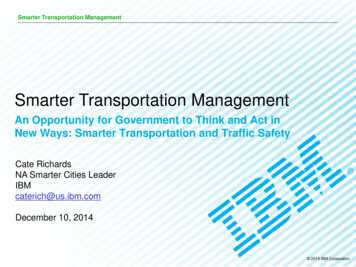

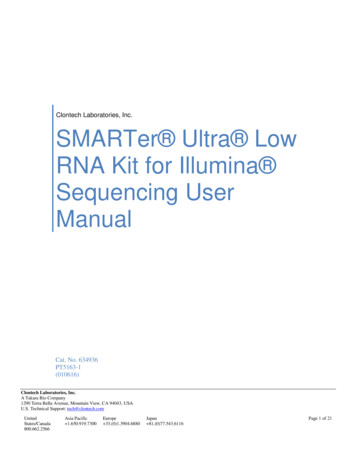
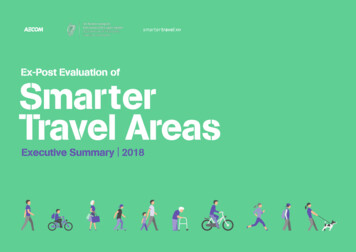
![Smarter Battery Crack [2022-Latest]](/img/13/eliamari.jpg)


